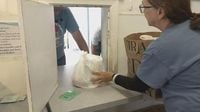As the federal government shutdown drags into its third week, millions of Americans are bracing for a looming crisis: the possible loss of food assistance that keeps families afloat. With Congress deadlocked and the White House silent on a path forward, the Supplemental Nutrition Assistance Program (SNAP)—better known as food stamps—faces an unprecedented funding shortfall that could leave more than 42 million people nationwide without help as early as November.
In Rochester, New York, the anxiety is palpable. On October 20, 2025, local advocates gathered at St. Peter’s Kitchen, a community hub for those in need, pleading with the Trump administration to maintain SNAP funding even as the shutdown shows no sign of resolution. Robert Boyd, CEO of St. Peter’s Kitchen, didn’t mince words: “What we’re really concerned about today is November SNAP benefits, and if these benefits are not paid, there’s about 64,000 people in the Rochester area that are going to be affected,” he told the assembled crowd, according to WROC.
For Isabel Rosa, advocacy coordinator for The Children’s Agenda, the stakes are deeply personal. “It is devastating my neighbors, it is devastating families, it is devastating children,” she said. “We have done nothing to deserve this. This treatment is cruel and it is merciless.”
This isn’t just a local issue. Across the country, from Connecticut to California, officials and advocates are sounding alarms about the impending collapse of a program that has long served as the backbone of America’s fight against hunger. The U.S. Department of Agriculture (USDA), which manages SNAP at the federal level, has warned that funding will run out in two weeks if lawmakers can’t strike a deal. Agriculture Secretary Brooke Rollins put it bluntly: “You’re talking about millions and millions of vulnerable families of hungry families that are not going to have access to these programs because of this shutdown,” she said outside the White House on October 16, as reported by Politico.
In Connecticut, the situation is especially dire. At a press conference in Hartford, Deputy Commissioner Peter Hadler of the state’s Department of Social Services acknowledged that food assistance for around 391,000 Connecticut residents could dry up on November 1 if the shutdown continues. “Our doors are open,” Hadler said. “We’re talking to everyone who’s concerned about this.” Lawmakers in the state are scrambling to find a solution. Governor Ned Lamont and legislative leaders are considering using a portion of last year’s budget surplus to temporarily fund SNAP, planning a special session in mid-November to hammer out the details. But the price tag is steep: it costs Connecticut $72 million every month to keep SNAP running.
Jason Jakubowski, president and CEO of Connecticut Foodshare, the state’s largest food bank network, praised state officials for their willingness to engage. “We are here in a state in which the state government is actually interested in figuring out, how do we help people? That’s not a conversation that’s happening in every state,” he noted. Still, he cautioned that food banks simply can’t fill the gap if federal aid disappears. “If SNAP funding runs out, many recipients will head to food banks, which will not be able to serve everyone,” Jakubowski warned.
The ripple effects are already being felt in other states. Minnesota has halted new enrollments in SNAP, and officials in Kansas, New Hampshire, and New Mexico have warned that residents could miss their food assistance payments for November. USDA, in an October 10 letter obtained by Politico, directed regional SNAP directors to stop working on benefits for November, instructing them to “hold their November issuance files and delay transmission to State EBT vendors until further notice.” The agency has already shuffled more than $300 million in tariff revenue into the Special Supplemental Nutrition Program for Women, Infants, and Children (WIC) to keep that smaller program afloat through October. But WIC is much smaller and cheaper to run than SNAP, serving about 52,000 people in Connecticut for $6 million a month, compared to SNAP’s hundreds of thousands and much higher cost.
California, with its vast population, is staring down a "perfect storm." As of June 2025, more than 5.5 million Californians were enrolled in CalFresh, the state’s version of SNAP. As the shutdown reached its 20th day, food banks from Sacramento to San Diego were bracing for the worst. Kevin Buffalino of Sacramento Food Bank & Family Services described the mood as one of deep uncertainty. “We’re in a really uncertain time here in our community,” he said, according to ABC News. Food banks, which already rely heavily on federal support, are preparing for a surge in demand that could quickly outstrip their resources. “It means the burden will be placed on the food banks and pantries—really all hunger-relief organizations,” said Casey Castillo, CEO of The Jacobs and Cushman San Diego Food Bank. In San Diego County alone, tens of thousands—including active-duty military personnel and federal workers missing paychecks—are expected to seek help.
The strain is already visible. “In one of our programs, last year folks were receiving about 16 items in their bag of food. Now, that is down to 10 items,” Castillo explained. With the holidays approaching, pantries like South Sacramento Interfaith are trying to stretch every resource. “We’re their bridge until they get back on their feet again,” said Simon Yeh, executive director of the food closet.
Governor Gavin Newsom didn’t hold back in assigning blame. “Trump’s failure to open the federal government is now endangering people’s lives and making basic needs like food more expensive—as the holidays arrive,” Newsom said in a statement. He warned that if the shutdown isn’t resolved by October 23, November delays to CalFresh benefits are almost certain.
Nationally, the backdrop to this crisis is a political standoff that shows little sign of abating. The shutdown began on October 1, 2025, after Congress failed to agree on a stopgap spending bill. Senate Democrats are pushing for negotiations to extend enhanced tax credits for those buying health insurance through the Affordable Care Act marketplace, while Republicans insist on passing a House version that omits those provisions. The result? Gridlock, finger-pointing, and real-world pain for millions.
Senator Richard Blumenthal of Connecticut, speaking at the Hartford press conference, tried to keep the focus on people, not politics. “If it isn’t addressed today, people won’t know whether they can afford health insurance, and they won’t buy it,” he said, emphasizing that the fight was about human rights, not party lines. He also sought to dispel misinformation, stating, “It is myth and misinformation that undocumented immigrants receive SNAP benefits.”
For many advocates, the crisis is about more than just food. Lisle Coleman, a community organizer for VOCAL-NY, called the situation “a direct war on the poor,” warning of a dismantling of social services that have long kept vulnerable families afloat. “We are seeing the most outright divide between the haves and the have-nots that this country has ever witnessed, and those at the top—the super elite—are becoming richer and richer while our families get more and more destitute, more hungry, more desperate,” Coleman said. “And without basic services like health care, we will see our community members get sicker and sicker, and we will see more deaths across the community as these cuts go into place.”
With each passing day, the pressure mounts—not just for lawmakers, but for families, food banks, and entire communities. Whether Washington can break the deadlock before November’s benefits run dry remains to be seen. But for millions of Americans, the stakes could hardly be higher.


